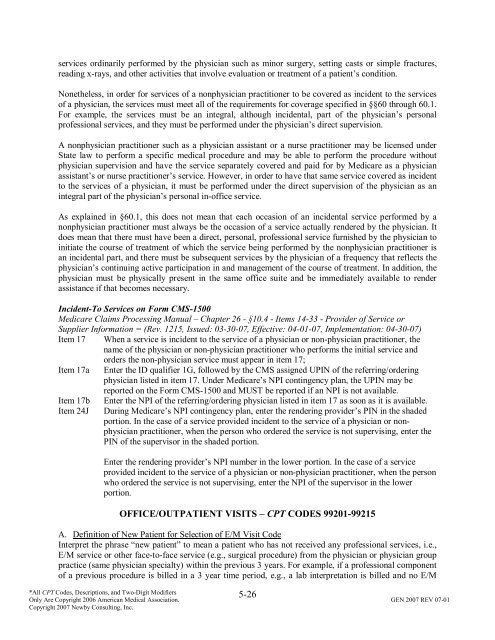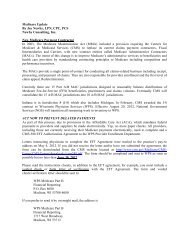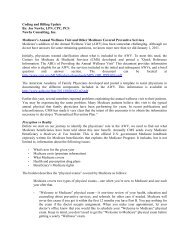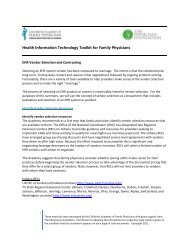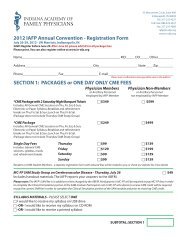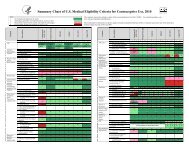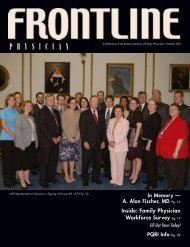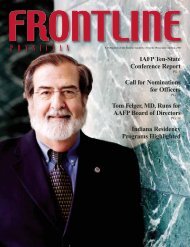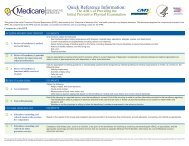pqri measure coding and reporting principles - Indiana Academy of ...
pqri measure coding and reporting principles - Indiana Academy of ...
pqri measure coding and reporting principles - Indiana Academy of ...
You also want an ePaper? Increase the reach of your titles
YUMPU automatically turns print PDFs into web optimized ePapers that Google loves.
services ordinarily performed by the physician such as minor surgery, setting casts or simple fractures,<br />
reading x-rays, <strong>and</strong> other activities that involve evaluation or treatment <strong>of</strong> a patient’s condition.<br />
Nonetheless, in order for services <strong>of</strong> a nonphysician practitioner to be covered as incident to the services<br />
<strong>of</strong> a physician, the services must meet all <strong>of</strong> the requirements for coverage specified in §§60 through 60.1.<br />
For example, the services must be an integral, although incidental, part <strong>of</strong> the physician’s personal<br />
pr<strong>of</strong>essional services, <strong>and</strong> they must be performed under the physician’s direct supervision.<br />
A nonphysician practitioner such as a physician assistant or a nurse practitioner may be licensed under<br />
State law to perform a specific medical procedure <strong>and</strong> may be able to perform the procedure without<br />
physician supervision <strong>and</strong> have the service separately covered <strong>and</strong> paid for by Medicare as a physician<br />
assistant’s or nurse practitioner’s service. However, in order to have that same service covered as incident<br />
to the services <strong>of</strong> a physician, it must be performed under the direct supervision <strong>of</strong> the physician as an<br />
integral part <strong>of</strong> the physician’s personal in-<strong>of</strong>fice service.<br />
As explained in §60.1, this does not mean that each occasion <strong>of</strong> an incidental service performed by a<br />
nonphysician practitioner must always be the occasion <strong>of</strong> a service actually rendered by the physician. It<br />
does mean that there must have been a direct, personal, pr<strong>of</strong>essional service furnished by the physician to<br />
initiate the course <strong>of</strong> treatment <strong>of</strong> which the service being performed by the nonphysician practitioner is<br />
an incidental part, <strong>and</strong> there must be subsequent services by the physician <strong>of</strong> a frequency that reflects the<br />
physician’s continuing active participation in <strong>and</strong> management <strong>of</strong> the course <strong>of</strong> treatment. In addition, the<br />
physician must be physically present in the same <strong>of</strong>fice suite <strong>and</strong> be immediately available to render<br />
assistance if that becomes necessary.<br />
Incident-To Services on Form CMS-1500<br />
Medicare Claims Processing Manual – Chapter 26 - §10.4 - Items 14-33 - Provider <strong>of</strong> Service or<br />
Supplier Information = (Rev. 1215, Issued: 03-30-07, Effective: 04-01-07, Implementation: 04-30-07)<br />
Item 17 When a service is incident to the service <strong>of</strong> a physician or non-physician practitioner, the<br />
name <strong>of</strong> the physician or non-physician practitioner who performs the initial service <strong>and</strong><br />
orders the non-physician service must appear in item 17;<br />
Item 17a Enter the ID qualifier 1G, followed by the CMS assigned UPIN <strong>of</strong> the referring/ordering<br />
physician listed in item 17. Under Medicare’s NPI contingency plan, the UPIN may be<br />
reported on the Form CMS-1500 <strong>and</strong> MUST be reported if an NPI is not available.<br />
Item 17b<br />
Item 24J<br />
Enter the NPI <strong>of</strong> the referring/ordering physician listed in item 17 as soon as it is available.<br />
During Medicare’s NPI contingency plan, enter the rendering provider’s PIN in the shaded<br />
portion. In the case <strong>of</strong> a service provided incident to the service <strong>of</strong> a physician or nonphysician<br />
practitioner, when the person who ordered the service is not supervising, enter the<br />
PIN <strong>of</strong> the supervisor in the shaded portion.<br />
Enter the rendering provider’s NPI number in the lower portion. In the case <strong>of</strong> a service<br />
provided incident to the service <strong>of</strong> a physician or non-physician practitioner, when the person<br />
who ordered the service is not supervising, enter the NPI <strong>of</strong> the supervisor in the lower<br />
portion.<br />
OFFICE/OUTPATIENT VISITS – CPT CODES 99201-99215<br />
A. Definition <strong>of</strong> New Patient for Selection <strong>of</strong> E/M Visit Code<br />
Interpret the phrase “new patient” to mean a patient who has not received any pr<strong>of</strong>essional services, i.e.,<br />
E/M service or other face-to-face service (e.g., surgical procedure) from the physician or physician group<br />
practice (same physician specialty) within the previous 3 years. For example, if a pr<strong>of</strong>essional component<br />
<strong>of</strong> a previous procedure is billed in a 3 year time period, e.g., a lab interpretation is billed <strong>and</strong> no E/M<br />
5-26<br />
*All CPT Codes, Descriptions, <strong>and</strong> Two-Digit Modifiers<br />
Only Are Copyright 2006 American Medical Association. GEN 2007 REV 07-01<br />
Copyright 2007 Newby Consulting, Inc.


